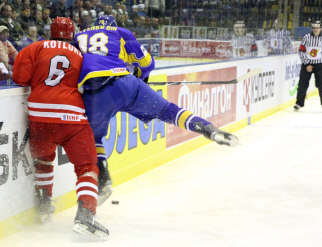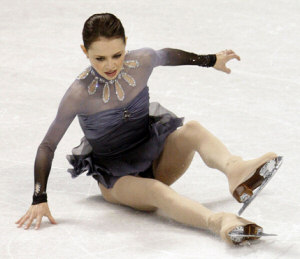Aggression in Sports
What is Aggression?
 Aggression
is any form of behavior toward the goal of harming or injuring another living
person who is motivated to avoid such treatment. Aggression
is any form of behavior toward the goal of harming or injuring another living
person who is motivated to avoid such treatment.
Hostile Aggression
Hostile aggression is any form of aggression aimed purely at hurting another
individual and where the primary reinforcement is seeing pain or injury
inflicted upon another person. This sort of vindictive behavior often occurs in
sports such as rugby when players become frustrated with negative results and
feel the need to resort to violence to resolve such a matter. Joey Barton, a
notoriously aggressive football player, for example, often resorts to hostile
aggression as a means of expressing his frustration.
Instrumental Aggression
Instrumental aggression, unlike hostile aggression, is not purely vindictive. It
is, instead, a means to an end. This type of aggressive behavior is executed in
order to reach a specific goal like victory or praise or tangible rewards such
as trophies or money. This type of behavior occurs in many sports but is
extremely common in the world of figure skating, especially amongst the ladies.
Skaters often abuse competitors before a competition. They destroy skates or
dresses or run into them during the warm up or practice session in order to
intimidate or unnerve them and gain the upper hand in the hopes of winning.
Assertive Behavior
 Assertive
behavior, the final type of aggressive behavior, is, like instrumental
aggression, utilized in the hopes of achieving a specific goal for the athlete.
Athletes exhibiting assertive behavior use legal physical or verbal force which,
beyond sport could be deemed as violent or aggressive. This type of aggression
is predominantly used in contact sports such as rugby and ice hockey. Strong
tackles, for example, are performed often in both sports and although they are
on the brink of being considered aggression, they are, in fact, adhering to the
rules of the sport. Football players in the German Bundesliga are taught to push
the boundaries of aggression without violating any of the agreed structures of
sport, resulting in the development of powerful, skillful and exciting way to
play football that has a growing fan base around the world. Assertive
behavior, the final type of aggressive behavior, is, like instrumental
aggression, utilized in the hopes of achieving a specific goal for the athlete.
Athletes exhibiting assertive behavior use legal physical or verbal force which,
beyond sport could be deemed as violent or aggressive. This type of aggression
is predominantly used in contact sports such as rugby and ice hockey. Strong
tackles, for example, are performed often in both sports and although they are
on the brink of being considered aggression, they are, in fact, adhering to the
rules of the sport. Football players in the German Bundesliga are taught to push
the boundaries of aggression without violating any of the agreed structures of
sport, resulting in the development of powerful, skillful and exciting way to
play football that has a growing fan base around the world.
Causes for Aggression
One postulation about the cause of aggression comes in the form of the Instinct
Theory. This hypothesis was formulated using Darwin’s evolutionary theory as a
basis and views aggression as inherent within human beings, an instinct
maintained even as humans evolved. In the struggle for survival, aggression is
viewed as inevitable. Those who adhere to this theory, also espouse the idea of
catharsis. The appellation, originally a Greek term used by Aristotle to denote
the idea of a sort of emotional release through drama, has a similar meaning
here. Instinct theorists view sports as a form of ‘cathartic release,’ a place
where one can channel their aggressive urges into more socially acceptable
behavior. If this theory is, in fact correct, then those athletes who exhibit
hostile aggression are likely to be the only individuals that it applies to.
These athletes have specific goals for which they are being aggressive and it is
plausible that they are merely exhibiting their more primal instincts within the
sport in the hopes of achieving a cathartic release. Players such as Joey
Barton, perhaps, resort to their basic instincts of aggression which were once
necessary for survival and channel it into their sports, resulting in violent
behavior for seemingly petty reasons.
 Another theory used by some to explain the causes of aggressive behavior is
the Frustration-Aggression Hypothesis. According to this theory, frustration
always leads to aggression which, in turn, is always the result of frustration.
Following this view, an athlete’s drive to achieve a goal will often be impeded
by some sort of obstacle which then leads to frustration and again,
subsequently, aggression. If this aggression is successful then the athlete will
experience feelings of catharsis. If, however, it is not, the athlete will
become increasingly frustrated and have a progressive need to be the aggressor.
This hypothesis best explains instrumental aggression as well as assertive
behavior. Both of these types of aggression are directed at achieving a certain
goal and an athlete’s frustration with any obstacle could indeed be the cause of
their aggression. Evgeni Plushenko, a renowned Russian figure skater, and Winter
Olympic gold and sliver medalist, is an excellent example of this theory in
action. During training, if other skaters get in his way, he becomes extremely
frustrated and often yells or storms off the ice. In this way, this hypothesis
is an extremely plausible explanation for the causes of aggressive behavior in
sport. Another theory used by some to explain the causes of aggressive behavior is
the Frustration-Aggression Hypothesis. According to this theory, frustration
always leads to aggression which, in turn, is always the result of frustration.
Following this view, an athlete’s drive to achieve a goal will often be impeded
by some sort of obstacle which then leads to frustration and again,
subsequently, aggression. If this aggression is successful then the athlete will
experience feelings of catharsis. If, however, it is not, the athlete will
become increasingly frustrated and have a progressive need to be the aggressor.
This hypothesis best explains instrumental aggression as well as assertive
behavior. Both of these types of aggression are directed at achieving a certain
goal and an athlete’s frustration with any obstacle could indeed be the cause of
their aggression. Evgeni Plushenko, a renowned Russian figure skater, and Winter
Olympic gold and sliver medalist, is an excellent example of this theory in
action. During training, if other skaters get in his way, he becomes extremely
frustrated and often yells or storms off the ice. In this way, this hypothesis
is an extremely plausible explanation for the causes of aggressive behavior in
sport.
One
hypothesis stems from Bandura’s Social Learning Theory. Albert Bandura, a
renowned psychologist, developed the Social Learning Theory in order to explain
the behavior of individuals. According to his theory, ‘role models’ are
extremely important in the development of children’s behavior or behavioral
change in certain environments. Bandura postulated that children tend to mimic
the behavior of their models (i.e. their parents, guardians or other leading
figures in their lives) and that social reinforcement or the feedback they
receive from their behavior further influences their actions. Children, or any
individual who receives positive feedback from their behavior, will be in turn
more likely to act in this manner again. In the same way, if negative feedback
is given to an individual, it is probable that they will attempt to stop
whatever behavior attracted the negative response. This theory applies equally
to all three different categories of aggression within sport. In sport, athletes
observe the behavior of those they admire, such as their coaches or old players,
and attempt to emulate their actions which, they perceive, have led to success.
Physical Fitness
Aggression in Sports
7 Simple Easy Ways to Stay Active
Exercise Tips for Busy Working Mothers
The Media's Role in Obesity
Easy Ways to Stay Toned and in Shape |